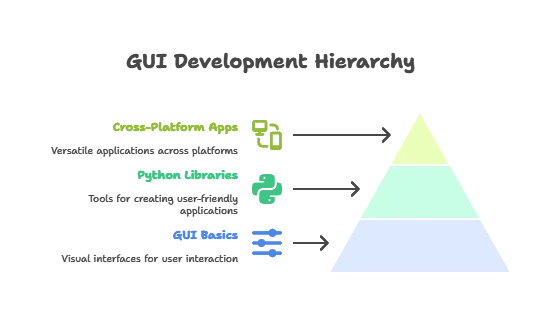Python GUI Development
Python GUI Development involves creating graphical user interfaces (GUIs) for software applications using Python programming language. GUIs enable users to interact with applications through visual elements such as buttons, menus, and text fields, making applications more intuitive and user-friendly.
Introduction to GUI Development
What is GUI Development?
GUI (Graphical User Interface) development involves creating visual interfaces that allow users to interact with software applications using graphical elements such as buttons, menus, and forms.
Why GUI Development in Python?
Python offers several libraries and frameworks for GUI development, making it accessible and versatile for creating user-friendly applications across platforms.

Basics of GUI Development with Python
Introduction to Tkinter
Tkinter is Python’s standard GUI toolkit, providing a simple and easy-to-use interface for building GUI applications.
Creating a Simple Window
import tkinter as tk
root = tk.Tk()
root.title("Hello Tkinter")
root.geometry("300x200")
label = tk.Label(root, text="Hello, Tkinter!")
label.pack()
root.mainloop()
Explanation:
- We import the
tkintermodule and create an instance of theTk()class to create the main window. - We set the title and size of the window using the
title()andgeometry()methods. - We create a
Labelwidget with the text “Hello, Tkinter!” and pack it into the window. - Finally, we start the GUI event loop with the
mainloop()method.
Handling Events
Tkinter allows us to bind functions to events such as button clicks and key presses.
Advanced Techniques in GUI Development
Building Complex Layouts
Tkinter supports various layout managers such as pack(), grid(), and place() for arranging widgets in complex layouts.
Using Custom Widgets
You can create custom widgets or extend existing ones to add advanced functionality to your GUI applications.
Integration with Other Libraries
Interacting with Data
You can integrate Tkinter with libraries like Pandas and Matplotlib to create interactive data visualization tools.
Web Integration
Using libraries like tkinterhtml, you can embed web content into Tkinter applications, enabling web integration.
Libraries and Frameworks for Python GUI Development
Tkinter
Tkinter is Python’s standard GUI toolkit, providing a simple and easy-to-use interface for creating GUI applications. It comes pre-installed with Python and is widely used for building desktop applications.
PyQt
PyQt is a set of Python bindings for the Qt application framework, offering a more powerful and feature-rich alternative to Tkinter. It provides support for advanced features such as 2D and 3D graphics, multimedia, and web integration.
wxPython
wxPython is another popular GUI toolkit for Python, based on the wxWidgets C++ library. It offers native look-and-feel on each platform and provides a wide range of widgets and controls for building cross-platform GUI applications.
Kivy
Kivy is an open-source Python library for developing multitouch applications, making it suitable for building interactive and touch-based user interfaces for desktop and mobile platforms.
Python GUI Development opens up a world of possibilities for developers to create interactive and visually appealing applications that cater to diverse user needs. From the simplicity and accessibility of Tkinter to the advanced features and capabilities of PyQt, wxPython, and Kivy, Python offers a versatile ecosystem for building GUI applications across platforms. Happy coding! ❤️
